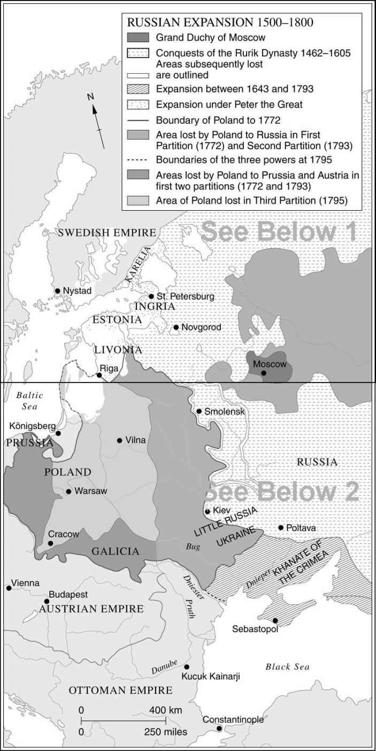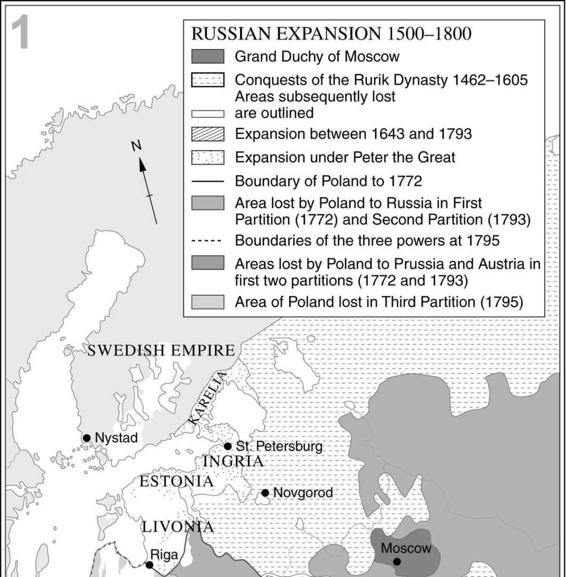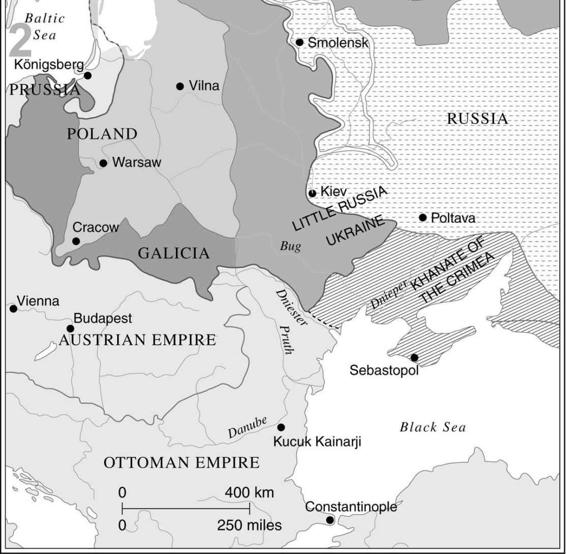The New Penguin History of the World (116 page)
Read The New Penguin History of the World Online
Authors: J. M. Roberts,Odd Arne Westad

The movement eastward was not much affected by the upheavals and dangers of the ‘Time of Troubles’ which followed Ivan’s death, though in the west there were moments when the outlet to the Baltic was lost and when even Moscow and Novgorod were occupied by Lithuanians or Poles. Russia was still not a serious European power in the early seventeenth century. The then rising strength of Sweden was thrown against her and it was not until the great war of 1654–67 that the Tsars finally regained Smolensk and Little Russia, not to be lost again (and then only briefly) until 1812. Maps and treaties now began to define Russia in the west in a way which had some reality. By 1700 she had acquired her first Black Sea stronghold, Azov, while her south-western frontier ran on the western side of the Dnieper for most of its length, embracing the great historic city of Kiev and the Cossacks who lived on the east bank. They had appealed to the Tsar for protection from the Poles and were granted special, semi-autonomous governmental arrangements which survived until Soviet times. Most Russian gains had been at the expense of Poland, long preoccupied with fighting off Turk and Swede. But Russian armies had joined the Poles against the Ottomans in 1687; this was a historic moment, too: the beginning of the classical Eastern Question which was to trouble European statesmen until 1918, when they found that the problem of deciding what limit, if any, should be placed upon Russian encroachment on the Ottoman empire in Europe had at last disappeared with the empires themselves.
The making of Russia was overwhelmingly a political act. The monarchy was its centre and motor; the country had no racial unity to preordain its existence and precious little geographical definition to impose a shape. If it was united by Orthodoxy, other Slavs were Orthodox, too. The growth of the personal domain and power of the Tsars was the key to the building of the nation. Ivan the Terrible was an administrative reformer. Under him appeared the beginnings of a nobility owing military service in return for their estates, a development of a system employed by the princes of Muscovy to obtain levies to fight the Tatars. It made possible the raising of an army which led the King of Poland to warn the English queen, Elizabeth I, that if they got hold of western technical skills the Russians would be unbeatable; the danger was remote, but this was prescient.
From time to time there were setbacks, though the survival of the state does not seem in retrospect to have been at stake. The last Tsar of the
house of Rurik died in 1598. Usurpation and the disputing of the throne between noble families and Polish interventionists went on until 1613, when the first Tsar of a new house, Michael Romanov, emerged. Though a weak ruler who lived in the shadow of his dominating father, he founded a dynasty which was to rule Russia for three hundred years, until the tsarist state itself collapsed. His immediate successors fought off rival nobles and humbled the great ones among them, the boyars, who had attempted to revive a power curbed by Ivan the Terrible. Beyond their ranks the only potential internal rival was the Church. In the seventeenth century it was weakened by schism and in 1667 a great step in Russian history was taken when the patriarch was deprived after a quarrel with the Tsar. There was to be no Investiture Contest in Russia. After this time the Russian Church was structurally and legally subordinated to a lay official. Among believers there would emerge plenty of spontaneous doctrinal and moral opposition to current Orthodoxy, and there began the long-lived and culturally very important movement of underground religious dissent called the
raskol
, which would eventually feed political opposition. But Russia was never to know the conflict of Church and state which was so creative a force in western Europe, any more than she was to know the stimulus of the Reformation.
The outcome was the final evolution of the enduring Russian governmental form, tsarist autocracy. It was characterized by the personification in the ruler of a semi-sacrosanct authority unlimited by clear legal checks, by an emphasis on the service owed to him by all subjects, by the linking of landholding to this idea, by the idea that all institutions within the state except the Church derived from it and had no independent standing of their own, by the lack of a distinction of powers and the development of a huge bureaucracy, and by the paramountcy of military needs. These qualities, as the scholar who listed them pointed out, were not all present at the start, nor were all of them equally operative and obvious at all times. But they clearly mark tsardom off from monarchy in western Christendom where, far back in the Middle Ages, towns, estates of the realm, guilds and many other bodies had established the privileges and liberties on which later constitutionalism was to be built. In old Muscovy, the highest official had a title which meant ‘slave’ or ‘servant’ at a time when, in neighbouring Poland-Lithuania, his opposite number was designated ‘citizen’. Even Louis XIV, though he might believe in Divine Right and aspire to unrivalled power, always conceived it to be a power explicitly restricted by rights, by religion, by divinely ordained law. Though his subjects knew he was an absolute monarch, they were sure he was not a despot. In England an even more startingly different monarchy was developing, one under the control of Parliament. Divergent from one another though English and French monarchical practice might be, they both accepted practical and theoretical limitations inconceivable to tsardom; they bore the stamp of a western tradition Russia had never known. For the whole of its existence the Russian autocracy was to be in the West a byword for despotism.



Yet it suited Russia. Moreover, the attitudes which underlay it seem in some measure to suit Russia still. Eighteenth-century sociologists used to suggest that big, flat countries favoured despotism. This was over-simple, but there were always latent centrifugal tendencies in a country so big as Russia, embracing so many natural regions and so many different peoples. To this day events have reflected this diversity. Russia had always to be held together by a strong pull towards the centre if the divergences within it were not to be exploited by the enemies on the borders.
The humbling of the boyars left the ruling family isolated in its eminence. The Russian nobility was gradually brought to depend on the state on the grounds that nobility derived from service, which was indeed often rewarded in the seventeenth century with land and later with the grant of serfs. All land came to be held on the condition of service to the autocracy as defined in a Table of Ranks in 1722. This effectively amalgamated all categories of nobility into a single class. The obligations laid on noblemen by it were very large, often extending to a man’s lifetime, though in the eighteenth century they came to be progressively diminished and were finally removed altogether. Nevertheless, service still continued to be the route to an automatic ennoblement, and Russian nobles never acquired quite such independence of their monarch as those of other countries. New privileges were conferred upon them but no closed caste emerged. Instead, nobility grew hugely by new accessions and by natural increase. Some of its members were very poor, because there was neither primogeniture nor entail in Russia and property could be much subdivided in three or four generations. Towards the end of the eighteenth century most nobles owned fewer than a hundred serfs.
Of all imperial Russia’s rulers the one who made the most memorable use of the autocracy and most deeply shaped its character was Peter the Great. He came to the throne as a ten-year-old child and when he died something had been done to Russia which could never be quite eradicated. In one way he resembled twentieth-century strong men who have striven ruthlessly to drag traditional societies into modernity, but he was very much a monarch of his own day, his attention focused on victory in war – Russia was only at peace for one year in his entire reign – and he accepted that the road to that goal ran through westernizing and modernizing. His ambition to win a Russian Baltic coast supplied the driving force behind
the reforms which would open the way to it. That he should be sympathetic to such a course may owe something to his childhood, growing up as he did in the ‘German’ quarter of Moscow where foreign merchants and their retinues lived. A celebrated pilgrimage he made to western Europe in 1697–8 showed that his interest in technology was real. Probably in his own mind he did not distinguish the urge to modernize his countrymen from the urge to free them for ever from the fear of their neighbours. Whatever the exact balance of his motives, his reforms have ever since served as something of an ideological touchstone; generation after generation of Russians were to look back with awe and ponder what he had done and its meaning for Russia. As one of them wrote in the nineteenth century, ‘Peter the Great found only a blank page… he wrote on it the words Europe and Occident.’
His territorial achievement is easiest to assess. Though he sent expeditions off to Kamchatka and the oases of Bokhara and ceased to pay to the Tatars a tribute levied on his predecessors, his driving ambition was to reach the sea to the west. He built a Black Sea fleet and annexed Azov (although he had to abandon it later because of distractions elsewhere, from the Poles and, above all, the Swedes). The wars with Sweden for the Baltic outlet were a struggle to the death. The Great Northern War, as contemporaries termed the last of them, began in 1700 and lasted until 1721. The world recognized that something decisive had happened when in 1709 the Swedish king’s army, the best in the world, was destroyed far away from home at Poltava, in the middle of the Ukraine where its leader had sought to find allies among the Cossacks. The rest of Peter’s reign drove home the point and at the peace Russia was established firmly on the Baltic coast, in Livonia, Estonia and the Karelian isthmus. Sweden’s days as a great power were over; she had been the first victim of a new one.
A few years before this, the French
Almanach Royale
for the first time listed the Romanovs as one of the reigning families of Europe. Victory had opened the way to further contact with the West, and Peter had already anticipated the peace by beginning in 1703 to build, on territory captured from the Swedes, St Petersburg, the beautiful new city which was to be for two centuries the capital of Russia. The political and cultural centre of gravity thus passed from the isolation of Muscovy to the edge of Russia nearest the developed societies of the West. Now the westernizing of Russia could go ahead more easily. It was a deliberate break with the past.
Even Muscovy, of course, had never been completely isolated from Europe. A pope had helped to arrange Ivan the Great’s marriage, hoping he would turn to the western Church. There was always intercourse with
the neighbours, the Roman Catholic Poles, and English merchants had made their way to Moscow under Elizabeth I, where to this day they are commemorated in the Kremlin by the presence of magnificent collections of the work of English silversmiths. Trade continued, and there also came to Russia the occasional foreign expert from the West. In the seventeenth century the first permanent embassies from European monarchs were established. But there was always a tentative and suspicious response among Russians; as in later times, efforts were made to segregate foreign residents.